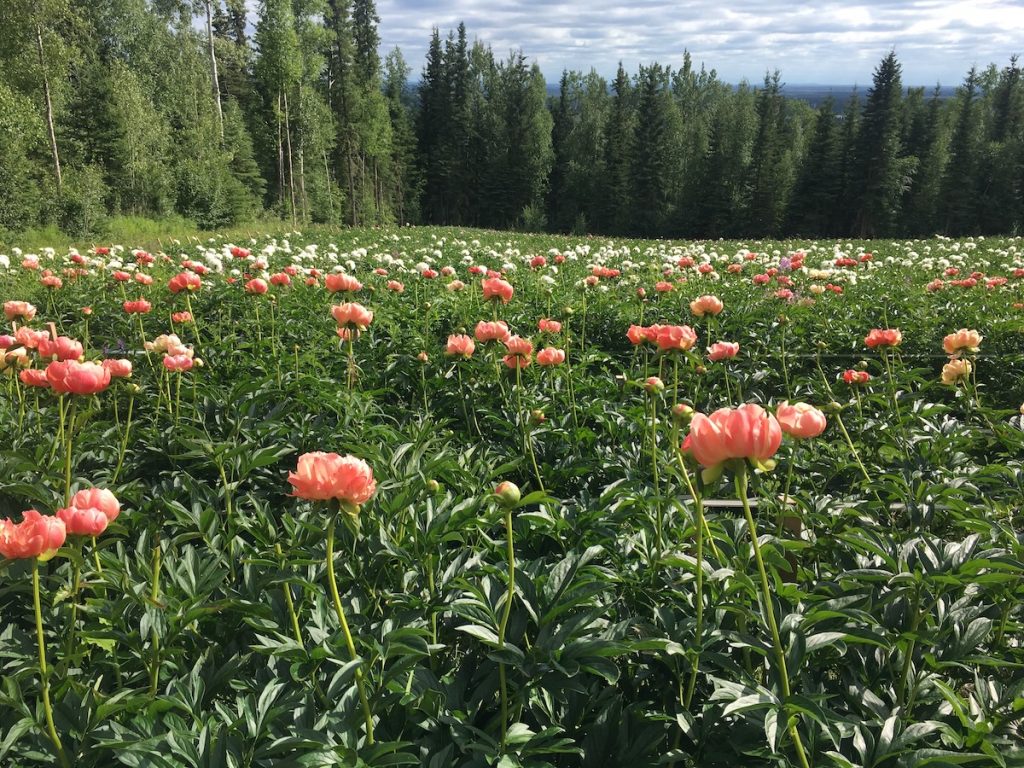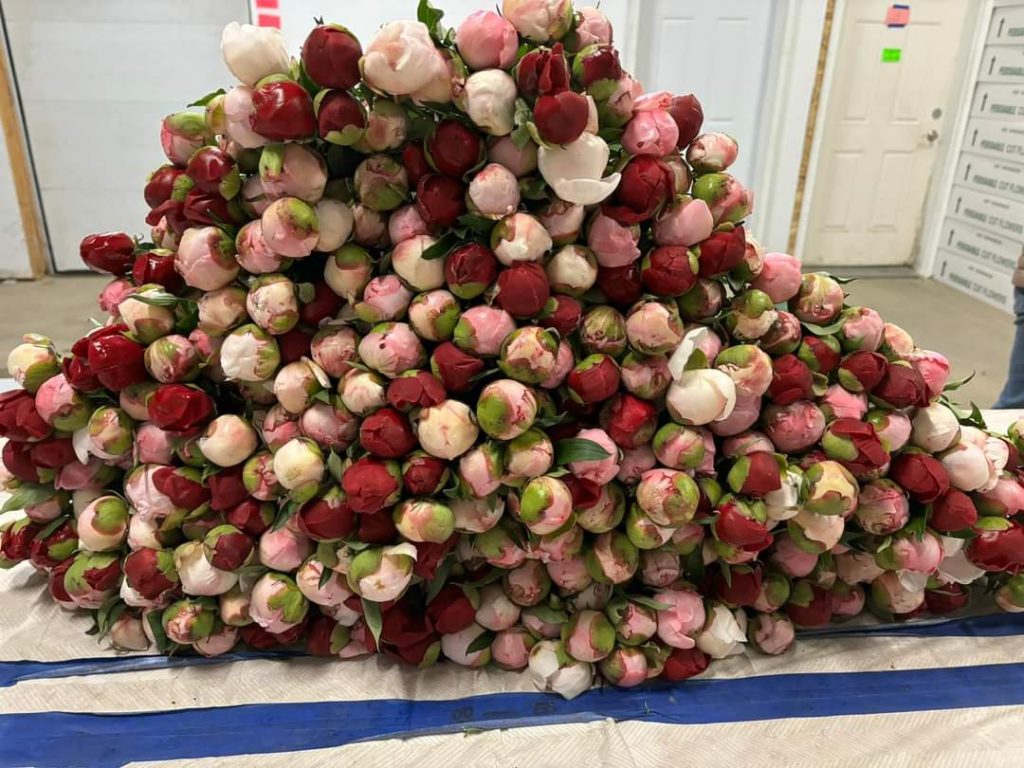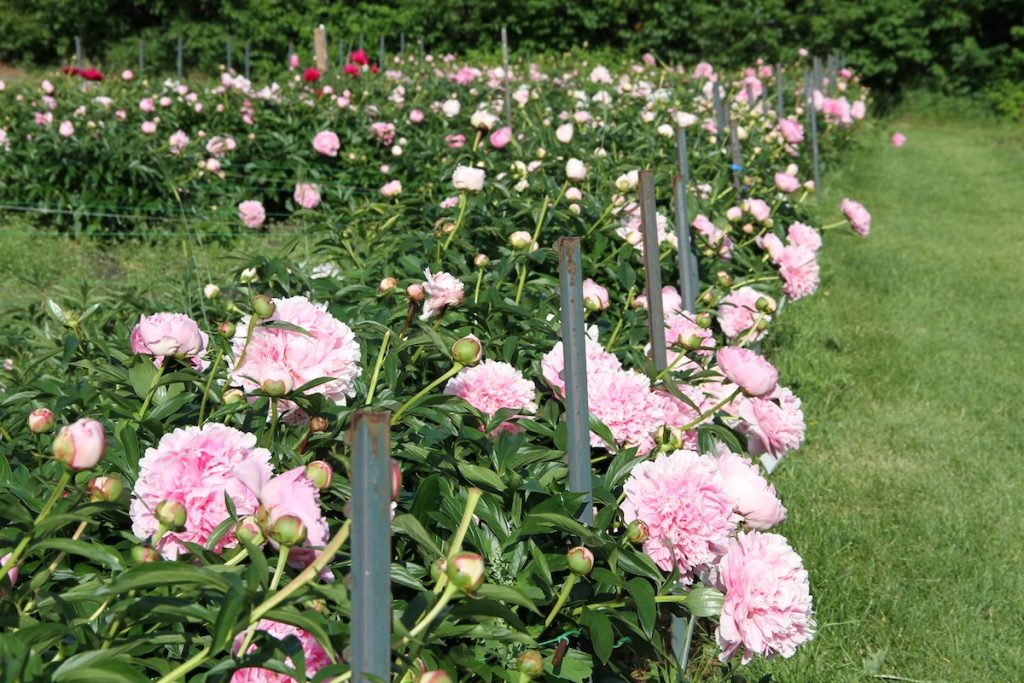Twenty-five years after University of Alaska Fairbanks horticulture researcher Pat Holloway’s initial discovery that Alaska held a niche in the peony market due to its unique bloom time and access to markets, the peony farming scene has ebbed and flowed.
From the first research plots being planted around 2001, to the boom between roughly 2014 and 2016, to post-COVID and high inflation rates that have left no business untouched, many farmers have come and gone. Those on the scene today are business savvy, hard-working, energetic, and have the health and lifestyles that allow them to focus on peonies full-tilt for at least six weeks during the height of the summer.
The peony farming gold rush in Alaska started because the flowers garnered a high price per stem due when they bloom. That is, they bloomed in Alaska in July and August during prime wedding season. At that time, peonies are not blooming elsewhere or at least nowhere with ready access to air transport and other infrastructure needed to export them.
The number of peonies planted in Alaska increased exponentially from 20 roots in 2004 to over 120,000 roots in 2012. In 2013, 150 peony farmers (or interested farmers) attended the Alaska Peony Growers Association (APGA) meeting which was close to the peak of interest. There was an effort to reach a global market (including Europe and Asia) through cooperatively marketed peonies.

APGA was instrumental in inspiring, educating and connecting new peony farmers, partly fueled by the desire to meet the demand of larger buyers through cooperatives like the Arctic Alaska Peony Cooperative. In the Last Frontier Magazine, North Pole peony grower Ron Illingworth said, “The thing we’re trying to do is to encourage people to get plants in the ground because we have the 100,000 stems-per-week demand.”
He said Asian and European markets were paying $4 to $10 stem, with the wholesale price at the lower end and the retail price at the higher end. In today’s dollars, that would be equivalent to $5 to $13 per stem.
Brad Fluetsch with Rainforest Peonies said he could earn up to $800,000 in a year in 2015, equivalent to more than a million in today’s dollars. Many jumped into the game with the lure of the high price per stem and potential falaskahigh income.
But stems actually sold for much less, more in the range of $3 to $5.50 a stem depending on grade, quantity, variety and market. A 2020 article that delineated different price points in different markets is still accurate, according to industry expert Ko Klaver and Boreal Peony farmers Rudy Klaver and Eli Brockman.
Looking at a few online stores in 2024, Fox Hollow sold individual stems for $3.50 to $6 each, depending on the variety. For 100 premium stems, the price was $4.50 and for 50 premium stems it was $5.50. North Pole Peonies sold 25 or more stems for $4.50 to $5 each. The Alaska Peony Market sold stems for $4 to $6.50 with no minimum order, plus shipping.
No one has become a millionaire from peony farming in Alaska, but there were two farms with sales over $100,000 in 2019 and 2020 according to USDA National Agricultural Statistics Service Floriculture Crop Summary. Rita Jo Shoultz, owner of Alaska Perfect Peony is one of those farmers and is the most successful peony farmer in Alaska. About half of her business is selling peony roots from Holland. She writes a blog with helpful information for other peony growers.

Cut flower sales (not grown in a greenhouse) in Alaska more than doubled from about $1 million in 2017 (from 100 farms) to $2.4 million in 2022 (from 121 farms). This includes diversified cut flower growers that may grow a handful of peonies or none at all. Looking at all farms in Alaska (not just peony farms) in 2022, the majority (62%; 724) reported net losses while 48 percent (449) reported net gains, of, on average, $60,727.
The real niche for Alaska peony farmers is the U.S. market, even though only 22% of the U.S. flower and foliage market is American-grown, according to Certified American Grown Flowers. Climate change and refrigeration capabilities do mean peonies are available from other sources at the same time as those grown in Alaska, but Ko Klaver, president and CEO of Botanical Trading Co. and floriculture industry expert, said even though you can store a peony for a long time, it’s never going to get any better.
Plus the Netherlands’ Shiphol Airport, which moves much of the world’s cut flowers, announced in 2024 that it was increasing airport fees by 37% over the next three years. Alaska has a distinct advantage in the U.S. market because of how much cheaper and easier it is to sell domestically versus internationally.
Martha Lojewski, executive director of the Alaska Peony Coop, explains why they don’t ship internationally anymore: “We shipped to Canada for three years. They would get stuck in customs, it would be unnecessarily delayed and the perishable product would no longer be usable by the time it got to the customer.”

Now that it’s a more mature industry, there may be real opportunities to get into peony farming:
- Peonies bloom in July and August in Alaska when they’re not really blooming elsewhere or at least not domestically and not in locations with good access to air transport. This presents a niche for the domestic market.
- A great deal of research has been done on peony farming in Alaska.
- Instead of starting a farm from scratch and needing to clear land, build soil, purchase roots, plant roots, and wait three to five years to sell stems, you may be able to purchase a peony farm that is in production.
- Education, advocacy, and support are available through the floriculture committee under the Alaska Farm Bureau.
- At least two peony cooperatives in Alaska help farmers pool resources, market and sell the stems, and share information: Alaska Beauty Peony Co-Op (11 farms) and the Alaska Peony Cooperative (six to nine farms; 10 years old).
There are some important questions to consider before starting a peony farm:
- Are you willing to learn and engage in all aspects of the business? You’ll need to learn how to grow the peonies, handle them post-harvest, market them, and ship them as well as run a business. Cooperatives may be able to help with some aspects of the business, but you can’t rely on that for sure, as some have failed.
- Are you willing to go the extra mile (literally) to market to your customers? Shoultz told me she travels across the country to meet and build relationships with her customers.
- According to a couple of farmers, break-even prices are $2 to $2.15, so you have to make sure you have a large enough market at a high enough price point to make a profit. You do not want to end up with too much product that you can’t move and have to dump it at a loss.
- How energetic are you? Shoultz said she puts in 15-hour days during the peak of the season. She is 82 years old. Rudy Klaver and Eli Brockman (both 19 years old) put in a 22-hour day at the peak. That may be a hard lift for many of us.
- Are you planting the farm in your backyard? This could link two large assets together — your farm and your house — which may mean you need to sell both when you only want to sell one. You can avoid this issue by living in tents or cabins on a separate farm property during the peony season or ensuring your house is far enough away, and on a separate lot from your fields.
- Do you want a new hobby or a business? Ko Klaver says many peony farmers started growing flowers more as a hobby, and hobbies cost money. On the other hand, Lojewski sees her farm more as a way to live a fulfilling lifestyle, and profit is secondary to that.
Lojewski, in a 2022 interview with Corrine Heck of Details Flowers, said there are a couple of key considerations before getting into peony farming: “Do you want to owe your life to the farm and do you have deep pockets? It takes at least five years to sell anything so you’ve got to have another source of income for those five years, and even after that years six, seven, and eight you’re crawling to get any kind of ground on monetary gain on a farm. It’s fun. It’s not for retirement. But it is so much work. It’s a lot of bending up and down, repairing irrigation lines pounding stakes, restringing things, 50 pounds of fertilizer. You have to be very inventive, creative, MacGyver everything.” She said that peony farming is a year-round job although peak season is July and August and she does try to take October off.
Do you want to owe your life to the farm and do you have deep pockets? Martha Lojewski
When I talked to Lojewski, she said even though she is business-minded about the farm, at the end of the day what she values is spending time with her family outdoors all summer, and if it pays for itself, that’s great. They live in an off-grid cabin near Willow, and they’re on farm time. Her kids eat when they’re hungry, go to bed when they’re tired, and have to find things to do other than being on screens. Everyone’s on deck during harvest time. They started with 5,000 plants but downscaled to 3,500 which, in addition to some reliable labor, has allowed them to enjoy the summer in Alaska more — hiking, paddle boarding, and more.
In an interview with Alaska Public Media’s Kim Sherry in 2024, Lojewski said, “Who doesn’t want to be a flower farmer? It sounds like a fabulous job on paper, right? Growing flowers and making people happy. You forget about the bugs and the weeds and picking in the rain.”
Some peony farmers have certainly found their place in the industry — overcoming challenges and reaping rewards — monetary or otherwise, and there is room for more.
Published in the Fairbanks Daily Newsminer February 16, 2025.